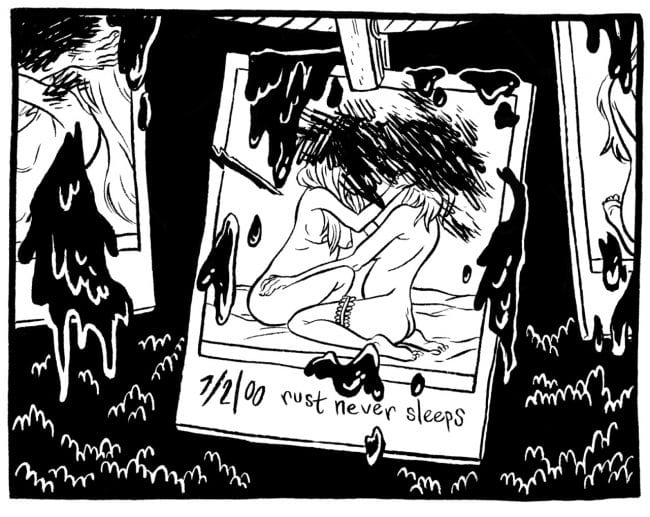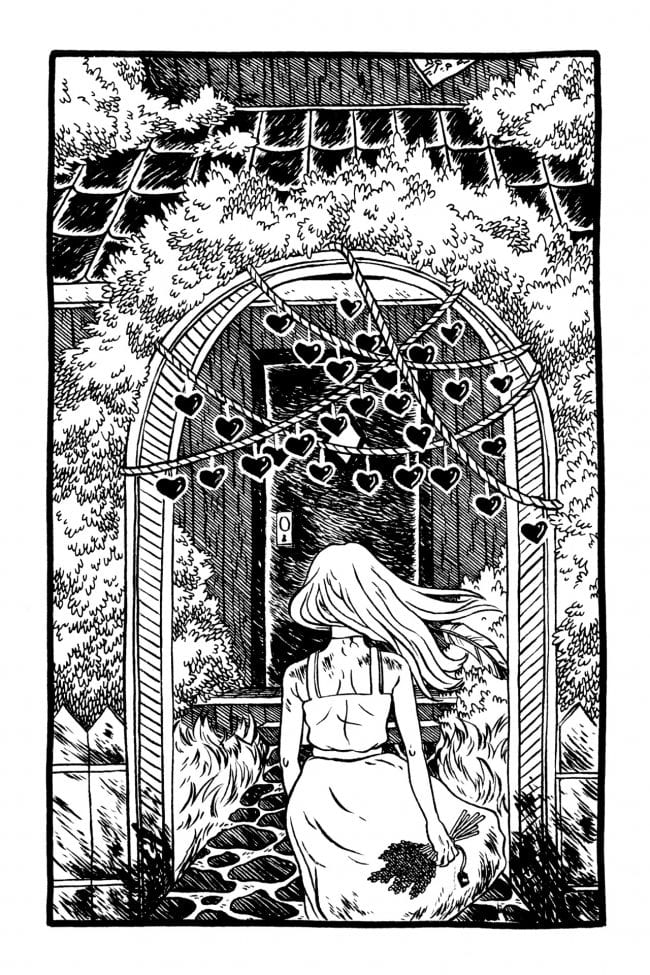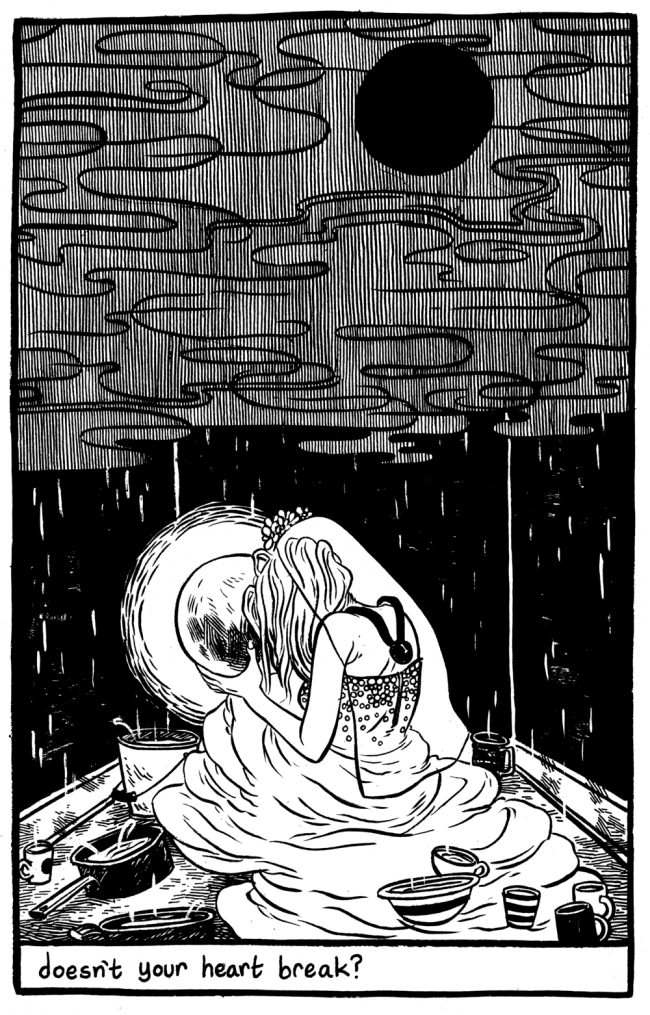Houses of the Holy is Caitlin Skaalrud's journey into the deepest, darkest memories and emotions. Clinically discussing the events that led to a certain conclusion would have done little to actually convey the experience, so instead Skaalrud chose to invent a visual language to depict and a poetic language to describe the events of a lifetime that led her main character to her lowest ebb. The book's blurb describes the journey as Dantean, but there's no Virgil present to explain what we're seeing to either Skaalrud's presumed stand-in character or to readers. Instead of a straightforward narrative, there's an emotional narrative wrapped in symbols, fragments, and genuinely harrowing sequences.
The book begins with a young woman sitting in a small house that's on an outcropping near the ocean. She's reading a book called How to Walk thru Fire, which seems to give her the inspiration to start her trek. As though she was opening the doors to her subconscious mind, she goes into the creepy basement of the building and starts unlocking door after door. Completely bare (except for the ribbon in her hair and a pair of boots) but also desexed, she comes face to face with the symbols of her mind's eye while she narrates her experiences. Behind each door is a memory, a feeling or a subconscious symbol of something she must confront. The narrator is going through the basement of her mind, clearing it out and eventually setting it all on fire. Each of the pages in this initial segment (previously printed as a minicomic) is staggeringly beautiful, with dense cross-hatching, whorls of wood, and scratched-out patterns on doors that open up into mysteriously bedecked rooms.
Burning down her house is the precursor to a long, dangerous journey through her subconscious. The first step is a forest filled with memories printed on photographs, most of them sexual and covered in ink, pinned to the branches of trees. Ink in this book is not a creative force but rather an obstructive force, something concealing memory and gumming up the works. Battered, bruised, burnt, and covered in ash, the protagonist finds a used dress to wear--a sort of suit of armor for protection. The forest she treks through is filled with hanging, exploding lightbulbs, horses that are being drowned, and a crown of thorns that she wears when pretending to be a martyr. There are a lot of Tarot-related images in the book, most of them relating to ruin.
At the midway point of the book, the protagonist finds herself in a deep pit, confronted by a now-spectral horse strangling her, as a number of images flash on the page. It's a moment of truth as she manages to climb out to continue her journey to confront more of herself. There's a moment of respite in a shop full of happy memories and comforting ritualistic items, but that moment doesn't last when she enters a gas station swimming in ink and confronts a pair of mossy legs in the bathroom. With the cracked door open, all we see is an overturned chair. At last, she confronts what she has tried to avoid, steeling herself with makeshift light as she starts to travel across the ocean.
Skaalrud then shows a series of highly naturalistic images in a room: a cigarette burning, a dog asleep, a baseball game in a particular inning... and finally pans to a slightly younger version of herself at a desk, writing suicide notes to her loved ones. There's a noose, and a chair and dangling feet--images that flash throughout the book--finally given not just context, but full emotional acknowledgment. Encountering a vision of Mother Death, the text reads "let go or be dragged." Her journey represents that letting go, as she walks through fire and winds up at her old house, now turned into a lighthouse.
There isn't a neat, easy happy ending that follows the grimness of the events we are shown. Indeed, the protagonist is on fire at the end of the book. But she's mastered the lessons of the book we see her with at the beginning. She has learned how to walk through fire and come out the other side. It doesn't mean that things aren't still on fire, that she's freed of the psychological and emotional burdens of her life, only that she's learned how to deal with them a little better. That she's parked on top of a lighthouse is a metaphor for the creation of the book itself. The process of the book clearly was therapeutic in a way, but she's also providing a potential light for others to see.

This is not an easy book to process, and it rewards multiple readings because Skaalrud's use of symbols is repetitious, and later events in the book help make some of the early symbology easier to understand. There was trauma, there was deep depression, and there was the decision to try to cross the threshold into death. There's nothing more unnerving than reading a series of notes from a failed suicide, because their firmness and even relief at the finality of the action combined with the enormous sense of guilt engendered by the act is overwhelming. At a certain point, the protagonist decided that it was over, but it wasn't, and this book in part is an exploration of the implications of that moment in time. It's a journey that had to be taken, or else, it's implied, she would eventually go down the same road as before if she didn't fully explore what the decision truly meant.
Variations of the phrase "Doesn't your heart break?" appear throughout the book, and it seems that the intense labor of making these drawings--the sheer, physical labor to create something beautifully decorative-- had an almost ritualistic quality. In other words, the decorative aspects of the book blend in with the poetic and metaphorical moments regarding accepting death's inevitability while coming to terms with one's own existence, grief, pain, and mental illness in the moment.











